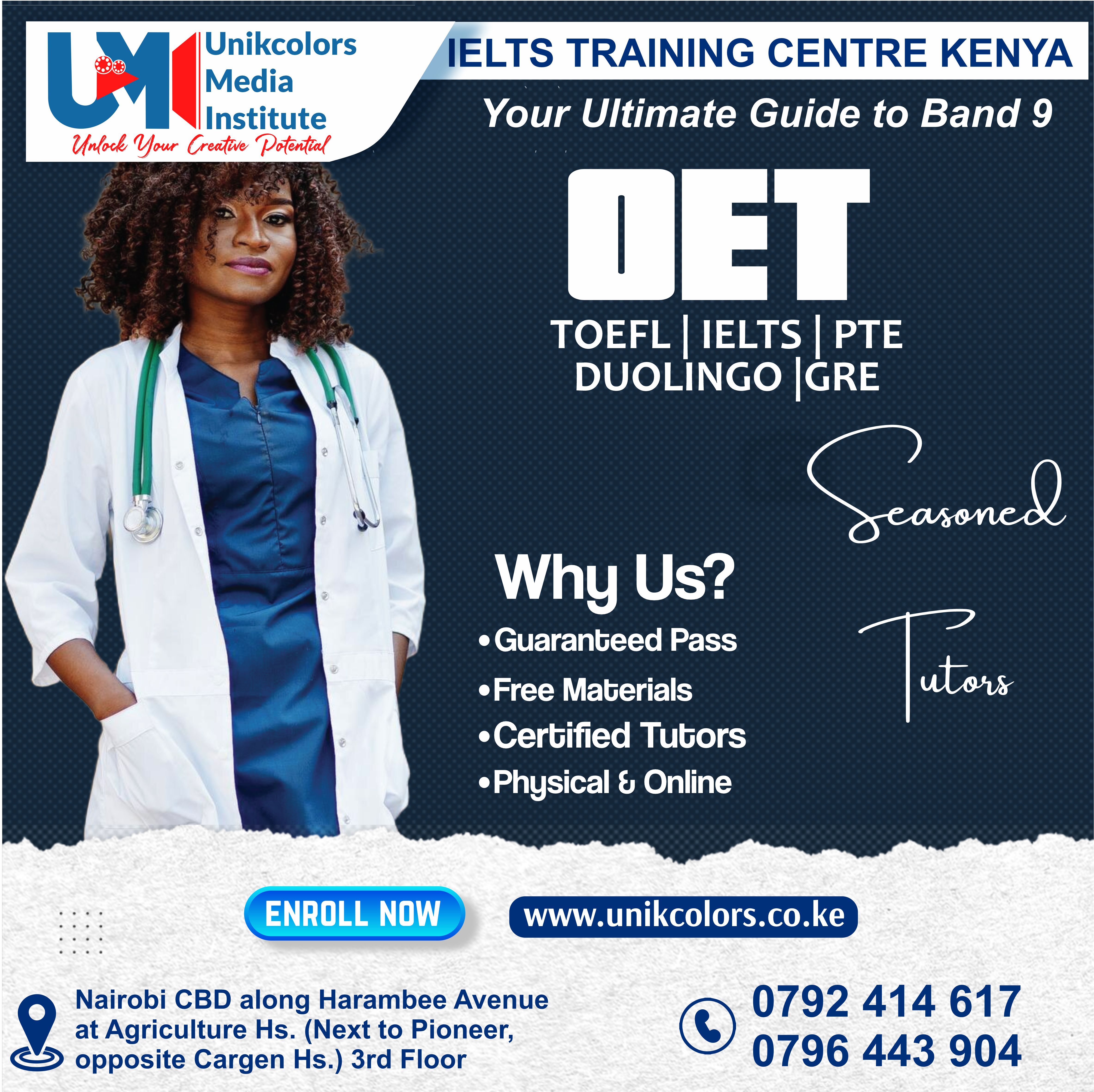IELTS TRAINING CENTRE KENYA - IELTS PREPARATION | OET | TOEFL | PTE | GRE | DUOLINGO

Title: IELTS TRAINING CENTRE KENYA - IELTS PREPARATION | OET | TOEFL | PTE | GRE | DUOLINGO
The Differences Between OET Reading Part A, Part B and Part C
There are three “parts†in the OET Reading test. While Part B and Part C are quite similar, Part A is very different. In this article, I’ll briefly outline the OET difference and similarities of each part of the OET Reading test so you know what expect on test day.
OET Reading Part A
Reading Part A is a ‘speed reading’ task that tests your ability to read ‘across’ various texts to find the answer. By ‘speed reading’, I mean the opposite of deep, considered reading. So instead of spending time understanding the details of the text, Part A requires you to do a lot of ‘looking for’, which is a type of reading.
In short, you are given four texts. Each of these texts will be on a certain topic and each of the four texts will be quite different.
For example, let’s say the topic is ‘headaches’.
One text might outline various types of headaches and their symptoms. Another text might outline various drugs and their means of administration. While another text might be a case study of a specific patient. One text will always be a visual graph of some sort – perhaps a table, or a bar chart or something like that.
The first set of questions always start with this phrase:
“In which text can you find information aboutâ€â€¦ followed by a list of information.
For example, question 1 might ask you:
“In which text can you find information about correct dosages for migraines?â€
To answer, just write on your page A, B, C, or D referring to the specific text that contained information about medication dosages.
Easy, no? The first set of questions is pretty straightforward.
The second and third set of questions in Reading Part A ask you to identify a specific word or phrase to answer a question or to complete a sentence. Remember that for these questions you take the words DIRECTLY from the text. There’s no need to transform the words at all, nor do you need to be creative and think of synonyms. Just remember to copy the word carefully from the text. This is important because if the word you copy is spelled incorrectly, it will be marked incorrectly.
As you can see, Reading Part A is all about reading quickly… you are almost ‘looking for’ information rather than deeply reading text to find meaning. It is quite different from Reading Part B and Part C.
OET Reading Part B
In OET Reading Part B you get a short (~150 words) workplace text and a multiple-choice question. There are three answer options: A, B or C. The function of the question — what the question is asking you to read for — will vary.
For example, sometimes the question will ask you to read for specific information such as:
“At what point should the medicine be administered?â€
Or sometimes the question will ask you what the main idea of the text is, such as:
“What is the point of this text?â€
Or sometimes the text will ask you what the purpose of the text is, such as:
“What is the purpose of this email?â€
This task seems easier than it actually is. The best way is to approach this task is to ignore the answer options altogether. Instead, make sure you’ve read the text first until you feel like you fully understand it. Then you can read the question and answer options and match one of the options to what you think is the answer. Of course, in doing so, sometimes the best way to identify the answer is to eliminate the incorrect answer options.
Remember, on test day you will get 6 of these Reading Part B questions. You should spend no more than 2 minutes on each to leave time for Part C.
OET Reading Part C
The question type for OET Reading Part C — multiple choice — is the same as Reading Part B. The texts, however, are quite different. You will get two 700-800 word semi-academic texts on a general medical topic. There will also be 6 multiple choice questions per text (so 12 in total). But instead of asking you about details, main ideas or purposes, Reading Part C is different. This section is much more about understanding the function of the text in terms of the writer’s opinions, attitudes and specific aspects of the text.
Some common question types in Reading Part C will quote people and ask questions such as:
“What does Jacky Lin think about the use of pressure mattresses?â€
Or…
“In the second paragraph, why does the writer include the information about ankle injuries?â€
Here, you have to understand the writer’s purpose and why the writer has included bits and pieces from various people and various sources. Reading Part C tests your ability to understand text deeply, rather than superficially, like in Reading Part A.
Keep in mind that for both Reading Part B and Reading Part C that there are two ways in which the questions will be phrased. The first type will be a direct question, like the two questions above. There is also another question type, which is an incomplete sentence, which may look something like this:
“In the third paragraph, Dr Mombasa recommends the use of…â€
And then one of the answer options will correctly identify what Dr. Mombasa actually recommended.
Anyway, that’s the theory behind the different question types. It’s good to know what you will face on test day. However, it’s another thing altogether practising good quality questions, especially with powerful step by step methods that make identifying the correct answer much easier.
